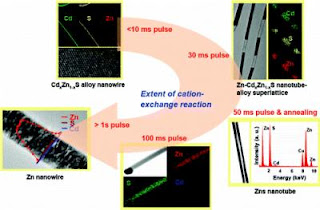PHILADELPHIA –- A team of engineers from the University of Pennsylvania has transformed simple nanowires into reconfigurable materials and circuits, demonstrating a novel, self-assembling method for chemically creating nanoscale structures that are not possible to grow or obtain otherwise.
The research team, using only chemical reactants, transformed semiconducting nanowires into a variety of useful, nanoscale materials including nanoscale metal strips with periodic stripes and semiconducting patterns, purely metallic nanowires, radial heterostructures and hollow semiconducting nanotubes in addition to other morphologies and compositions.
Recent research in the field has enabled the transformation of nanomaterials via solid-phase chemical reactions into nonequilibrium, or functional structures that cannot be obtained otherwise.
In this study, researchers transformed single-crystalline cadmium sulfide nanowires into composition-controlled nanowires, core−shell heterostructures, metal-semiconductor superlattices, single-crystalline nanotubes and metallic nanowires by utilizing size-dependent cation-exchange reactions along with temperature and gas-phase reactant delivery control. This versatile, synthetic ability to transform nanowires offers new opportunities to study size-dependent phenomena at the nanoscale and tune their chemical/physical properties to design reconfigurable circuits.
Researchers also found that the speed of the cation exchange process was determined by the size of the starting nanowire and that the process temperature affected the final product, adding new information to the conditions that affect reaction rates and assembly.
"This is almost like magic that a single-component semiconductor nanostructure gets converted into metal-semiconductor binary superlattice, a completely hollow but single crystalline nanotube and even a purely metallic material," said Ritesh Agarwal, assistant professor in the Department of Materials Science and Engineering at Penn. "The important thing here is that these transformations cannot take place in bulk materials where the reaction rates are incredibly slow or in very small nanocrystals where the rates are too fast to be precisely controlled. These unique transformations take place at 5-200 nanometer-length scales where the rates can be controlled very accurately to enable such intriguing products. Now we are working with theoreticians and designing new experiments to unravel this 'magic' at the nanoscale."
The fundamental revelation in this study is a further clarification of nanoscale chemical phenomena. The study also provides new data on how manufacturers can assemble these tiny circuits, electrically connecting nanoscale structures through chemical self-assembly.
It also opens up new possibilities for the transformation of nanoscale materials into the tools and circuits of the future, for example, self-assembling nanoscale electrical contacts to individual nanoscale components, smaller electronic and photonic devices such as a series of electrically connected quantum dots for LEDs or transistors, as well as improved storage capacities for batteries. ###
The study, published in the current issue of the journal Nano Letters, was conducted by Bin Zhang, Yeonwoong Jung, Lambert Van Vug and Agarwal of the Department of Materials Science and Engineering in Penn's School of Engineering and Applied Science.
The work was supported by a National Science Foundation Career Award and a Penn Materials Research Science and Engineering Center grant.
Contact: Jordan Reese jreese@upenn.edu 215-573-6604 University of Pennsylvania
















No comments:
Post a Comment